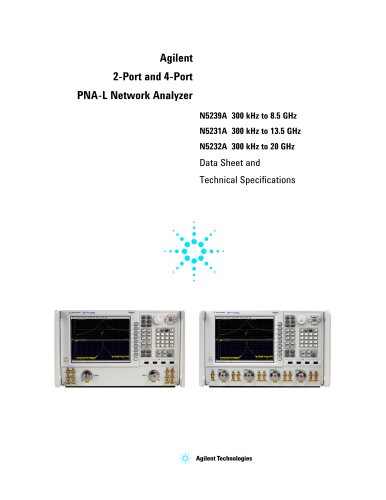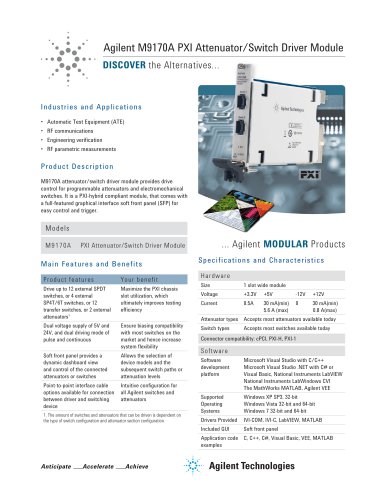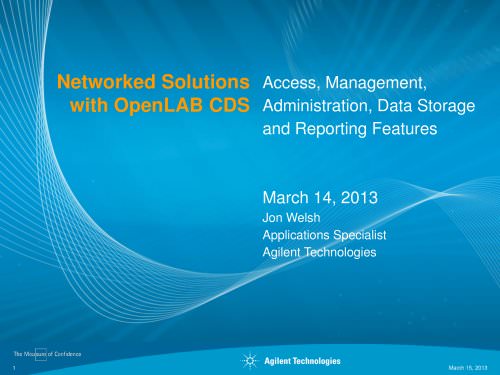
Catalog excerpts

Leave Interferences Behind With MS/MS. Agilent 8900 Triple Quadrupole ICP-MS
Open the catalog to page 1
Put Your ICP-MS Results Beyond Doubt Reliable interference removal is easier to achieve with the 2nd generation Agilent 8900 ICP-QQQ. In 2012, Agilent released the Agilent 8800, the world’s first triple quadrupole ICP-MS (ICP-QQQ) with MS/MS capability. This ground-breaking instrument created new analytical possibilities for analysts in hundreds of laboratories around the world. The 2nd generation Agilent 8900 ICP-QQQ suits a range of situations, from routine contract analysis to research, and materials analysis. The 8900 ICP-QQQ has the helium mode performance and productivity of Agilent’s...
Open the catalog to page 2
Proven ICP-QQQ Technology Agilent’s unique triple quadrupole ICP-MS uses MS/MS, enabling hundreds of labs around the world to do more than ever before. Life science and biopharma Dissolved metal and particulate contamination of process chemicals and materials is a major issue for semiconductor manufacturing. ICP-QQQ is used to monitor lower levels of ultratrace contaminants in raw materials, bulk chemicals, and wafer processing baths to ensure high product yield and minimize failure rates. Accurately measuring trace level contaminants in the environment is more important than ever. Agilent...
Open the catalog to page 3
Be Sure With ICP-MS/MS The Agilent 8900 ICP-QQQ provides outstanding performance for existing multi-element ICP-MS applications. The 8900 also introduces analytical capabilities not previously possible using ICP-MS. Low-level determination of previously difficult elements, separation of direct isobaric overlaps, and fast, trace analysis of emerging nano-scale materials extend the application of ICP-MS into new fields of analysis. Ultratrace analysis of Si and S Resolve isobaric overlaps Si and S suffer from intense polyatomic interferences and have not previously been possible to measure at...
Open the catalog to page 4
Accurate analysis of sulfur and sulfur isotope ratios using MS/MS Nanoparticle (NP) characterization using single particle/cell ICP-MS (sp/scICP-MS) Using O2 cell gas, S can be measured as the product ion SO+ at m/z 48 (for the major 32S isotope), 49, and 50. Measurement of multiple isotopes allows S isotope ratio analysis and accurate quantification using isotope dilution (ID). The 8900 ICP-QQQ with MS/MS is essential for this application, as carbon, calcium and titanium can cause interference when the SO+ product ions are measured without MS/MS, as illustrated, following. The 8900 ICP-QQQ...
Open the catalog to page 5
Leave Interferences Behind With MS/MS Ultra High Matrix Introduction (UHMI) UHMI increases matrix tolerance up to 25% total dissolved solids (TDS). UHMI is standard on the 8900 Standard and Advanced Applications configurations, ensuring high matrix samples can be measured routinely, and eliminating matrix suppression. Sample Introduction Low-flow, Peltier-cooled sample introduction system provides stability and consistency. Optional Integrated Sample Introduction System (ISIS 3) adds a piston pump and close-coupled 7-port valve for high-speed discrete sampling. Gas Control Four channel...
Open the catalog to page 6
First Quadrupole Mass Filter (Q1) High frequency, hyperbolic quadrupole mass filter. In MS/MS, Q1 operates at 0.7 u resolution, rejecting all masses except the target analyte mass, and so controlling reaction chemistry in the cell. 4th-Generation Octopole Reaction System (ORS4) Temperature-controlled collision/reaction cell with a 4-channel gas controller for flexibility in cell gas methods. Operates in helium (He) mode and also provides effective, consistent control of interferences in reaction mode with MS/MS. Axial acceleration (Advanced Applications and Semiconductor configurations)...
Open the catalog to page 7
Powerful, Flexible, Intuitive ICP-MS Software Preset methods and automation ICP-MS MassHunter software uses an intuitive Task Navigator and toolbar layout, making it easy to learn and use: – The home tab provides easy access to common setup and operation functions, such as Startup, Batch, and Acquisition Queue. – he acquisition pane brings together tune settings, T element selection, and acquisition parameters. IntelliQuant Assistant preselects preferred cell modes for each analyte, providing even simpler method setup. – he sequence pane contains the sample list, and the T queue pane...
Open the catalog to page 8
Extend Your Nanoparticle or Single Cell Analysis Preset methods for nanoparticle and single cell analysis ICP-MS MassHunter’s optional Single Nanoparticle (NP) Application Module includes preset methods for both single particle analysis (spICP-MS) and nanoparticle analysis using field-flow fractionation (FFF-ICP-MS). Measurement of the metal content of single cells (scICP-MS) is also supported. The spICP-MS Method Wizard uses predefined and user-entered values to calculate essential method variables. Calibration of particle size and number is performed automatically using the analysis of...
Open the catalog to page 9
Proven Speciation Capability Integrated speciation with ICP-QQQ Fully heated GC interface Environmental, food safety, pharmaceutical, and consumer product regulations increasingly require the identification and quantification of elemental species as well as total concentrations. Agilent offers the most comprehensive range of integrated speciation systems and methods for ICP-QQQ, including LC, GC, CE, IC, FFF, and more. Agilent’s unique GC-ICP-MS interface is heated to the tip of the injector (up to 300 ºC) for routine analysis of high-boiling point compounds. The flexible transfer line and...
Open the catalog to page 10
SPS 4 Autosampler A great choice for medium- and highthroughput applications, with rack configurations providing up to 360 vial positions. Integrated cover protects samples from dust and airborne contamination. Agilent I-AS Autosampler with pumped rinse station Agilent Integrated Sample Introduction System (ISIS 3) Ideal for ultratrace analysis in high purity semiconductor chemicals, and for analysis of small sample volumes (0.5 mL). Flexible rack configurations offer a maximum capacity of 89 vials, plus 3 rinse vials. High-speed uptake pump, and closecoupled 7-port switching valve provide...
Open the catalog to page 11All Agilent Technologies - Life Sciences and Chemical catalogs and technical brochures
-
Agilent 280 Series AA Systems
12 Pages
-
Inorganic Standards
40 Pages
-
InfinityLab LC Supplies
148 Pages
-
General Chromatography
164 Pages
-
Sample Preparation (2018/2019)
144 Pages
-
MS500
12 Pages
-
FLAME ATOMIC ABSORPTION SPECTROSCOPY
104 Pages
-
Agilent training
27 Pages
-
AGILENT VACUUM PRODUCTS CATALOG
536 Pages
-
Vacuum Measurement Catalog
44 Pages
-
AGILENT ION Pumps
53 Pages
-
AGILENT DIFFUSION PUMPS
35 Pages
-
AGILENT Rotary Vane Pumps
29 Pages
-
Agilent InfinityLab LC Series
16 Pages
-
3100 fractionator
8 Pages
-
4200 MP-AES
12 Pages
-
Agilent GPC/SEC Solutions
12 Pages
-
Agilent?s biomass solutions
12 Pages
-
X-ray Crystallography
12 Pages
-
Agilent ProPulse NMR System
5 Pages
-
An autosampler like no other
4 Pages
-
Agilent U1450A/U1460A
19 Pages
-
Agilent B1507A
22 Pages
-
Agilent M9703A
16 Pages
-
W1905 Radar Model Library
16 Pages
-
M8048A ISI Channels
7 Pages
-
Agilent J-BERT M8020A
27 Pages
-
Agilent N8900 Series
10 Pages
-
I/O Hardware
16 Pages
-
Advanced Design System
16 Pages
-
RF & Microwave Attenuators
4 Pages
-
E4980AL Precision LCR Meter
8 Pages
-
FieldFox Handheld Analyzers
8 Pages
-
AFM/SPM Accessories
20 Pages
-
VEE 9.32
24 Pages
-
89600 VSA Software
9 Pages
-
Command Expert
2 Pages
-
E5061B Network Analyzer
8 Pages
-
E5071C ENA Network Analyzers
18 Pages
-
N9038A MXE EMI Receiver
2 Pages
-
N9322C Basic Spectrum Analyzer
10 Pages
-
Digital Multimeters
25 Pages
-
M9361A PXI Downconverter
2 Pages
-
Power Meters and Power Sensors
34 Pages
-
E7515A UXM Wireless Test Set
2 Pages
-
Agilent Power Products
31 Pages
-
E5063A Network Analyzer
8 Pages
-
Leak Detection Catalog
41 Pages
-
Agilent 7820A GC brochure
8 Pages
-
Agilent GC-MSD and QTOF
96 Pages
-
Agilent GC-MSD 5977
39 Pages
-
Agilent Intro BERLIN
24 Pages
-
1290 Infinity Quaternary LC
24 Pages
-
1260 Infinity Bio-inert
26 Pages
Archived catalogs
-
Diffusion Pumps Catalog
37 Pages






















































































































































